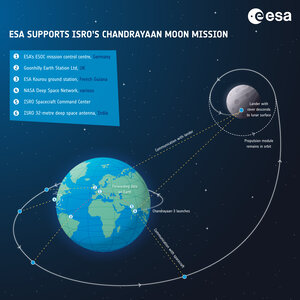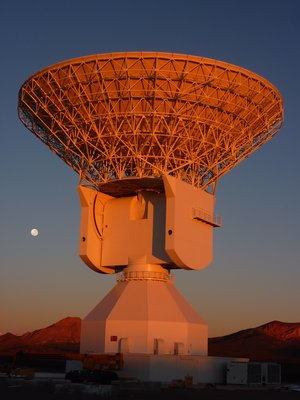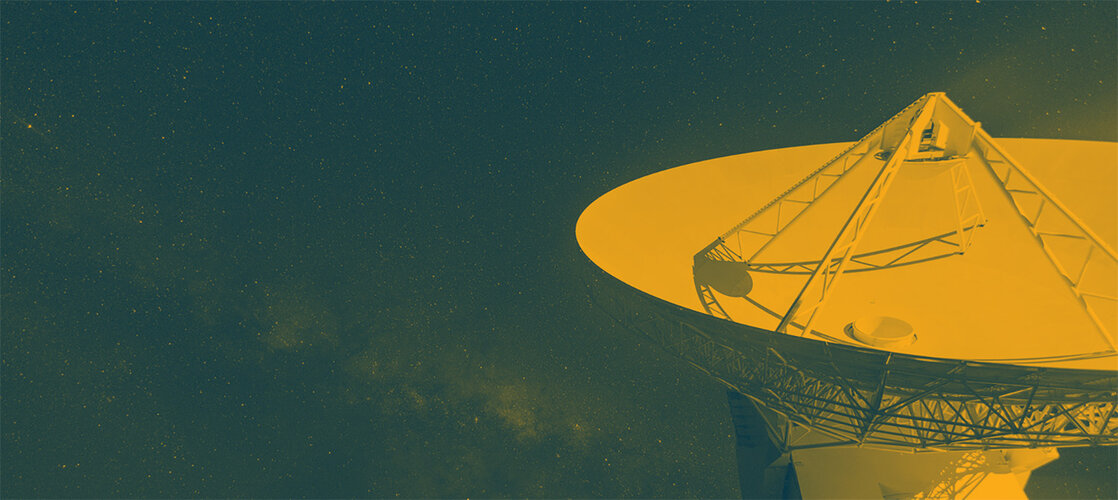India’s Chandrayaan-3 successfully lands on the Moon
The Indian Space Research Organisation (ISRO) has successfully landed its Chandrayaan-3 Lander Module on the surface of the Moon.
What happened?

Chandrayaan-3 launched from the Satish Dhawan Space Centre in Sriharikota Range (SDSC SHAR), India, on 14 July 2023 on a mission to demonstrate new technologies and to achieve India’s first soft landing on another celestial body.
The spacecraft arrived in lunar orbit on 5 August. On 17 August, the lander module separated from the propulsion module and soon after began its descent to the surface.
On 23 August, after a nail-biting wait, ISRO confirmed that Chandrayaan-3’s lander had successfully touched down in the Moon’s southern polar region as planned.
“Congratulations ISRO on this historic landing. ESA is proud to support the Chandrayaan-3 mission. Our ground stations are a core element of ESA’s support to its international partners, and I am pleased that with this activity, we are further strengthening ESA’s relationship with ISRO and with India. I look forward to supporting further pioneering ISRO missions, such as Aditya-L1, in the future,” says Rolf Densing, Director of Operations at ESA’s ESOC mission operations centre in Darmstadt, Germany.
How was ESA involved?

ESA is providing deep space communication support to the Chandrayaan-3 mission.
Communication is an essential part of every space mission. Ground stations on Earth keep operators connected to spacecraft as they venture into the unknown. Without ground station support, it’s impossible to get any data from a spacecraft, to know how it’s doing, to know if it is safe or even to know where it is.
For the Chandrayaan-3 mission, ESA is coordinating routine support from its Kourou station in French Guiana and from Goonhilly Earth Station Ltd in the UK. These stations compliment support from NASA’s Deep Space Network and ISRO’s own stations.

ESA’s 35-metre antenna in New Norcia, Australia, provided additional tracking support during the lunar landing, serving as a back-up for ISRO’s own ground station.
New Norcia received the stream of vital signs from the Chandrayaan-3 lander – information about its health, location and trajectory – in parallel with the ISRO station. This type of back-up support is common during key moments of a space mission such as a landing.
It was this stream of telemetry that was ultimately used to confirm the success of the landing.
ESA’s deep space support to international partners

Many national space agencies operate deep space tracking stations that enable them to locate, track, command and receive telemetry and scientific data from their distant spacecraft.
But sometimes, particularly for deep space missions, operators need to track or command a spacecraft when it is outside the field of view of their own antennas, or to have a second ‘pair of eyes’ on their spacecraft during crucial moments.
Thanks to its global ‘Estrack’ network of ground stations, ESA can help its partners track, command and receive data from spacecraft almost anywhere in the Solar System via its ESOC mission operations centre in Darmstadt, Germany.
The Estrack network consists of ESA’s own ground stations, located across the globe, and ESA-coordinated support from third-party stations such as Goonhilly Earth Station Ltd.
What happens next?
The lander will soon deploy its rover. During its mission on the surface, which will last for one lunar day (14 days on Earth), the rover will carry out a number of scientific experiments.
ESA stations will continue to relay telemetry and scientific data gathered by the mission’s rover and lander module until the end of the surface operations.
Follow @esaoperations on Twitter/X for updates on ESA’s support to Chandrayaan-3.








